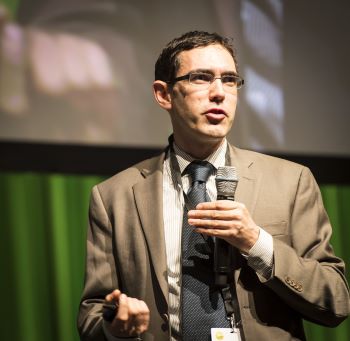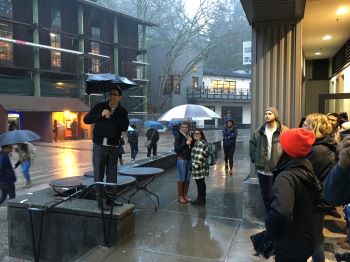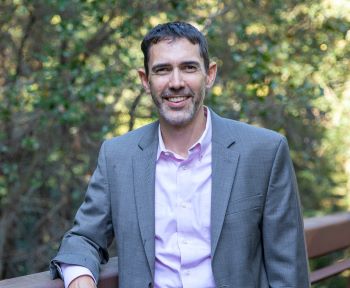Tell us a bit about yourself, your background, and how your path led to where you are today.
My path was certainly not carefully planned. I grew up and went to school in Britain, and my first job after graduation was writing for a transportation policy magazine. After coming to the US, I worked for an urban planning consulting firm. I began to realize that I enjoyed the research side of the job—for example, I led a project on car-sharing—and so I applied to PhD programs. In graduate school, I found out I liked teaching as well.
I see that you’ve done some work with urban sprawl and car ownership, could you tell us a little bit about that?
Working with Chris Barrington-Leigh at McGill University, I’ve spent the past five years computing measures of street-network sprawl for every mapped street and intersection on Earth. Culs-de-sac, gated communities, and tree-like branches are characteristic of sprawl—it’s hard to walk from these types of neighborhoods to a grocery store, a school, a gym, or any other destination, because the walking routes are so indirect. Therefore, people drive. And because the streets are permanent, they lock in car dependence pretty much forever. Gated communities are also a way for the (usually white and wealthy) privileged to, quite literally, wall themselves off from the rest of the city, entrenching patterns of segregation.
Unfortunately, street-network sprawl is on the rise in almost every country. But we can look for inspiration to many places that are founded on connected streets and continue to build in this way—Tokyo and Buenos Aires, for example. These cities provide models for how to grow in a more sustainable way.
How has your work with McGill University differed from the work you’ve done at UCSC?
Before I came to UCSC, I taught in the Geography Department and School of Environment at McGill University in Montreal. Geography is very similar to environmental studies—it’s interdisciplinary and concerned with human-environment interactions and spatial processes.
What does Sustainability mean to you?
I think of sustainability as a broad umbrella for advancing both environmental protection and social equity.

You’ve included an image here that shows you speaking at an Eco Congress in February of 2014, can you share that experience with us? Why did you speak there and what message did you convey?
I was speaking about peak travel—the observation that in almost every rich country, people stopped driving more around the year 2000. Even though planners and energy forecasters still predict that car travel per capita will continue to increase, that’s at odds with the reality. The implication: many projects to expand road capacity for cars are misguided and unsustainable.
Since 2013, you have assisted in the Carbon Fund through consultation or direct committee representation. What could you say about your experience doing this
It’s been incredibly rewarding to see the variety of projects that we’ve been able to support through the Carbon Fund, from energy efficiency to bikes to rainwater harvesting, and on campus and in the broader community. Most of these projects were initiated by students.
During your time at UCSC, you taught a Pedestrian Planning Class. Could you tell us a little about that?
For the past few years, I’ve taught a senior seminar on pedestrian or bicycle planning. (The most recent was generously supported by the Carbon Fund.) The students have designed improvements to campus or city streets, working with TAPS and the city’s Transportation and Public Works Commission.
One student team’s proposal to redesign Water Street with protected bike lanes helped catalyze the city to do exactly that, taking advantage of a repaving project when the street would have been dug up anyway. You can read more of the student projects here.
The students found that protected bike lanes, just like those that just went up on Water Street, are the single biggest change that would give more people the confidence to ride a bicycle, not just the daredevil minority. A major obstacle, however, is opposition to the removal of parking spaces, which is sometimes required. Many people at UCSC and in Santa Cruz think of themselves as green or progressive, but then they prioritize a parking space for themselves over the safety of pedestrians and cyclists. For example, the bike lanes at the bottom of Bay Street turn into parking spaces after 6pm and on weekends, so that residents don’t have the inconvenience of parking on a side street half a block away. This is one of the busiest bike routes in the city, and bicycles don’t magically

disappear at 6pm.
Can you elaborate on the work you’ve done coordinating buses in Santa Cruz?I haven’t done any coordination directly with Metro, but I’ve worked with students to identify some of the problems with reliability and pass-bys, and potential solutions. It’s absurd that anyone has to wait for 2, 3, or 4 buses to go past before they can squeeze on. Or that there are gaps of nearly an hour between buses on Western Drive.
As with bikes and pedestrians, there are some quick fixes that would speed up buses, provide more capacity, and reduce operating costs. For example, why not allow all-door boarding on Metro buses? San Francisco did it and reduced boarding times by 38%. At root, however, we need to get buses out of traffic. There’s no way to widen campus roadways, and so the priority should be to cut the number of cars on central campus—for example, by gradually reducing the amount of parking, and making the top part of Hagar Drive, past the bookstore, open to buses and emergency vehicles only (as called for in the campus’ Long-Range Development Plan). You shouldn’t need to leave an hour early just to get to class from downtown.
The campus Sustainability Plan sets goals of reducing commute vehicle travel by 5%, and per-capita parking demand by 10%. I don’t see how these goals can be achieved without both speeding up buses and gradually reducing the supply of parking.
What is the most rewarding part of your position as a professor?I enjoy hearing from my students after they graduate from UCSC. I’d hope that my research has an impact on the world too, but it’s much more tangible to see the activism, teaching, entrepreneurship, and other contributions that my students make after their graduation. I’ve run into Environmental Studies alumni in many walks of life—working for city governments, at the farmer’s market, and in urban planning.
I also enjoy the field trips. They were an inspirational part of my own undergraduate education, whether climbing around on glaciers or analyzing public transportation systems. So I’ve been pleased to take UCSC students to tour urban farms and affordable housing developments in San Jose, green buildings such as Ecology Action’s headquarters, and on a city bike tour. Thank you to the people and organizations that opened up their doors to the class!
What do you do for fun?
With the pandemic, I’ve been spending much more time camping in the Sierras and other parts of California. Fortunately, our dog seems to like it. He also likes riding along in my bike basket, even if he tries to jump out at the sight of a squirrel.
Adam has spent eight years as an Assistant Professor in the Environmental Studies Department at UCSC and received the 2019 Excellence in Teaching Award during his time here. His research focused on urban planning, environmental economics, and key challenges in transportation, energy, and climate change policy. He currently works to examine the global patterns of urban sprawl and car ownership, the effectiveness of local climate planning efforts, and the design of carbon trading programs. Adam is looking forward to joining UCLA in January 2021 as an Associate Professor in the Department of Urban Planning.
See Adam’s research website for more details of current projects and past publications.

